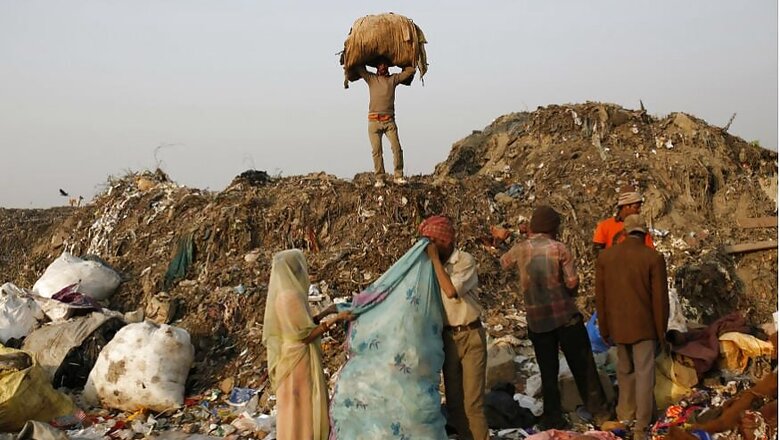
views
New Delhi: A sea of plastic spreads through the New Delhi slum of Taimur Nagar, a symbol of the grime and waste that makes the Indian capital one of the world's most polluted cities.
The plastic bottles, bags, food wrappers and other detritus have gushed out of a drain that ends in the shanty, leaving stinking sewer water clogging the roads.
Stray dogs, goats and cows munch the plastic waste as toddlers run around trying to retrieve footballs and water bottles.
India is to be the focus of World Environment Day on Tuesday, but it is far from the minds of the long-suffering inhabitants of Taimur Nagar.
"You can see how bad the conditions are here. It's completely choked with plastic," said Bhola Ram, shaking his head.
Taimur Nagar is one of many slums in Delhi and countless other Indian cities struggling to cope with waste, particularly the plastic pollution that is the main theme of World Environment Day.
India is to organise beach cleanups, an exhibition of green technology and art installations — symbols of its growing economic clout. One engineer, Rajagopalan Vasudevan, has developed a process where plastic waste is shredded up and used in new roads.
A plastic hell
But a sweeping look over Taimur Nagar underlines the challenges the country faces with its waste.
India generates around 5.6 million tonnes of plastic waste annually, according to government figures, with Delhi among the worst cities for plastic consumption.
The city banned plastic bags in 2009 and later expanded it to all plastic packaging and single-use disposable plastic.
But the ban is rarely enforced. Plastic bags are still the staple for carrying vegetables, fruit, meat and restaurant takeaways.
Taimur Nagar's residents know little of the hazards of non-biodegradable plastic to the water supply and the animals sat around.
Used to the filth, residents say they are resigned to their fate.
"It's like living in hell. You can see there is plastic garbage everywhere. We are poor and we have no choice but to live and die here," said Shreepal Singh, a waste dealer.
Conditions were always not so bad.
"When I came here 40 years ago the drain had clean water. The area was not so dirty. But as more and more people started living here, things have gone worse," said Saroj Sharma, a mother of three.
In the rainy season, grimy water from sewers enters homes with families having to cope with the sludge and stench.
"My granddaughter keeps falling sick. All the children here frequently miss school because they are down with diarrhoea or malaria," said housewife Birambati Devi as pigs feasted on a stinking garbage dump nearby.
Taimur Nagar is sandwiched between upper scale residential developments lined with swanky houses, the underbelly of Delhi that remains hidden from main roads.
Its insidious conditions tell a sorry tale of India's lopsided economic growth as well as decades of negligence, despite a pledge by Prime Minister Narendra Modi to clean up the country by the time his term ends in 2019.
India, Asia's third-largest economy, had 14 of the world's 15 worst cities for dirty air in a recent World Health Organization survey.
Delhi improved its ranking to sixth from the most polluted city in 2014.
"I don't think the city will ever get cleaned. The conditions will never improve," said Sallu Chowdhary, who wore a black mask as he set out for college.
"No one is serious about this problem, not even the locals who have to suffer every day."


















Comments
0 comment